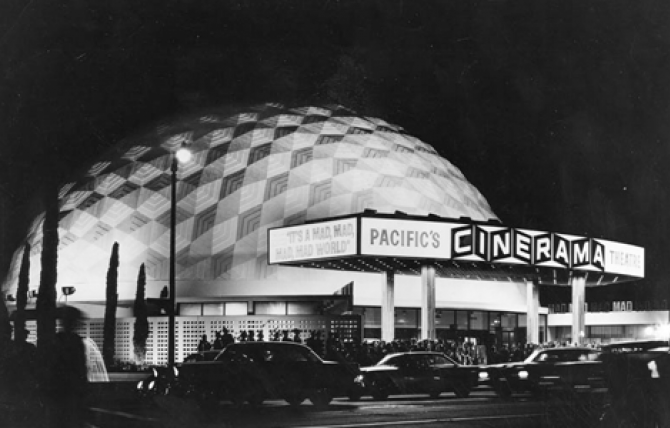The Cinerama Dome (1963) shown at the time of its opening. The geodesic dome, built as a prototype Cinerama, a widescreen projection process, was threatened with demolition in 1998. (Security Pacific National Bank Collection)
What’s your favorite Los Angeles landmark? Does it still stand, or is it just a memory?
Angelenos have been demolishing landmarks as long as we’ve been building them. Nearly every square inch of the city used to be something else, and many places that rose on the ashes of landmarks have gained their own significance over time.
Most of what we typically consider landmarks are beautiful works of architecture, but they’re also much more. Landmarks distinguish and anchor communities. They’re tangible history, offering an experience that words or images never could. They connect us with our past and each other. They educate and inspire. They reflect our values as a society. Some landmarks are icons; others are neighborhood gems. Some aren’t even pretty, but they play key roles in conveying our culture.
It’s hard to hold on to our landmarks in a city like Los Angeles, which has reinvention in its DNA. The freedom and innovation that fostered L.A.’s unique architectural legacy now threaten its survival—particularly in a place with relentless development pressure and concentrated power over land-use decisions.
Stylistic trends also play a role. Downtown’s Richfield Building was an Art Deco masterpiece demolished in 1968, when many considered the style passé. Landmarks are particularly vulnerable at around age forty—like the Richfield—and their style has reached its nadir. By the time the pendulum of popular taste swings back in their direction, it’s too late.
The good news is, a lot of people care about historic places in Los Angeles, and they work tirelessly to preserve them. We all play a role, from leading preservation efforts, to contacting elected officials when an important place is threatened, to sharing our love of landmarks with our friends.
Some people consider “historic Los Angeles” an oxymoron. Yes, L.A. is a relatively young city; our landmarks need a chance to grow old. If we can keep them standing long enough—occupied and relevant—just imagine the legacy Los Angeles can have centuries from now.
This exhibit highlights just a few of the many landmarks in and near Los Angeles that fell to the wrecking ball or narrowly escaped. There’s much more to each of these stories, and there are many more stories like them.
Some of the stories cross paths in unexpected ways. The original home of the Atomic Café was razed to make way for Parker Center, now itself slated for demolition. Bart Lytton, who tore down the Garden of Allah to build a bank (now itself a landmark and facing demolition), tried to preserve the Dodge House as part of a housing development. One place is both lost and almost lost: Terminal Island, which lost its Japanese fishing village to bigotry in World War II but retains the last vestiges of its rich maritime and commercial history.
I hope these stories illustrate not just pretty buildings, but the integral role of historic places in our lives. Preservation is really about people, and it takes people to save what’s left of our cultural heritage.

